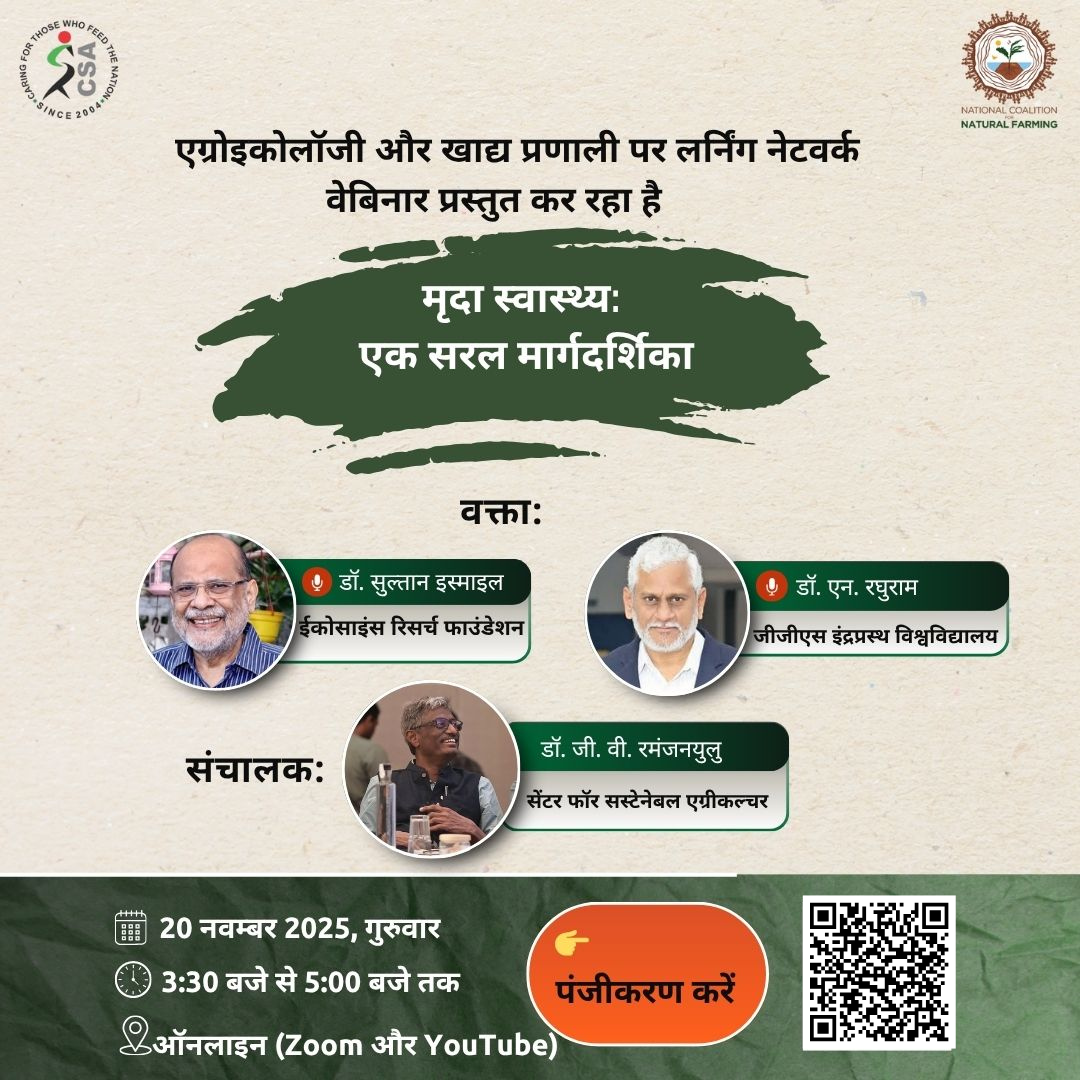Webinar Report on ‘Understanding Soil Health: A Practical Guide’ by NCNF and CSA

1. Introduction
NCNF[1] and CSA[2] jointly organised a webinar titled “Understanding Soil Health: A Practical Guide” as part of their continuing efforts to build collective learning on agroecology and natural farming across India. The session brought together two eminent experts — Dr Sultan Ahmed Ismail (Ecologist and Soil Biologist, EcoScience Research Foundation) and Dr N. Raghuram (Professor, GGSIP University & President, Sustainable India Trust). The webinar was moderated by Dr GV Ramanjaneyulu (Executive Director, CSA). Participants included NGO field staff, producer-collectives, farmers, researchers, and students.
[1] National Coalition for Natural Farming (NCNF)
[2] Centre for Sustainable Agriculture (CSA)
2. Setting the Context
The discussion was opened by Dr GV Ramanjaneyulu, who emphasised the need for a comprehensive transition in India’s soil health management: integrating cropping patterns, ecological needs, market incentives, and policy frameworks. The session highlighted the importance of moving beyond binary narratives and adopting holistic, system-level approaches. Soil degradation maps from IIT Delhi and ISRO were referenced, showing clear declines in soil organic carbon and nutrient balance across large parts of the country.
The conversation encouraged practitioners to view soil as a living ecosystem, rather than a medium for external inputs.
3. Key Insights from Dr Sultan Ahmed Ismail
Dr Ismail described soil as a living system, using simple explanations and metaphors to illustrate microbial activity, soil respiration, the roles of earthworms, and nutrient movement. Key points included the soil acting like a living organism, simple field tests for assessing soil quality, and the vital importance of organic matter, earthworms, mulching, and moisture retention.
- Soil as a Living System
- Healthy soil contains 50% solid matter, 25% air, 25% water, and millions of microorganisms.
- Microbes, fungi, and earthworms drive nutrient transformation and soil structure.
- Soil “breathes” and aeration is essential for biological activity.
- Field-Friendly Soil Quality Tests: He explained simple tests that farmers can conduct, like the earthworm count, aggregate stability, smell and colour of soil, and water infiltration tests. These decentralised assessments can help farmers avoid sole dependence on government labs.
- Organic Matter and Mulching
- Mulching is essential for moisture retention, lowering temperature, preventing erosion, and feeding soil biota.
- Organic matter is the foundation for long-term fertility.
- On Inputs and Manures
- Manure is more effective for quick nutrient release than compost.
- Local microbial solutions and farmyard manures are more reliable, and it is better to avoid purchasing commercial microbial cultures.
- Integration of livestock greatly strengthens nutrient cycling.
- Natural farming practices: He explained
- Broad-spectrum bio-input preparation using cow dung
- The importance of keeping soil covered
- Crop-soil matching: “Any soil can grow something well if we choose the right crop.”
4. Key Insights from Dr N. Raghuram
Dr Raghuram expanded on the scientific basis of soil health- focusing on nutrient cycling, fertilizer overuse, pollution, and sustainable cropping choices. He emphasized the need for balanced physical, chemical, and biological parameters; selecting varieties with deeper root systems; and reducing over-fertilisation.
- Nitrogen Use & Pollution:
- Only 30–40% of the nitrogen applied is absorbed by crops
- The rest becomes pollution — affecting air, water, and soil
- Two-thirds of global nitrogen pollution comes from agriculture
- India’s Policy Commitments: He highlighted
- India’s leadership in global nitrogen management
- National targets to reduce nutrient waste by 50% by 2030
- The need for balanced NPK regulation and rational subsidy redesign
- Sustainable crop choices and root architecture: varieties with deeper root systems improve soil aeration, carbon buildup, and moisture movement. Promoting 50:50 legume: non-legume ratios can self-regulate nitrogen.
- Market and Policy Levers: MSP redesign towards legumes and oilseeds can shift cropping patterns. Over-focusing on rice and wheat (due to procurement policies) distorts soil health.
5. Discussion Highlights
Participants discussed soil testing challenges, confusion between soil fertility and fertiliser need, the role of mulching and cover crops, and the importance of decentralised soil assessments. The Q&A also covered topics such as composting, manure management, root architecture, and reducing chemical dependency. The suggestions given for the above are:
- Soil Testing Challenges – Participants raised issues with delayed and inaccurate government soil test reports; lack of calibration and improper sampling; mismatch between soil fertility and fertiliser recommendations. Experts suggested strengthening decentralised soil assessments using field indicators.
- Compost, Manure & Bio-Inputs – Discussions clarified that manure gives quicker nutrient release; compost adds stable carbon to the soil; local solutions are both more ecological and economical than purchased microbial cultures; and mulching/cover crops are essential for building the soil organic matter (SOM).
- Crop-Soil Suitability – Farmers often choose crops based on market demand rather than soil conditions. The speakers stressed the need for locally-adapted varieties, deeper-rooted crops, and legumes for nitrogen cycling.
- Integration of Livestock – animal husbandry, particularly dung and urine management, is foundational for sustainable nutrient cycles.
- Carbon Farming & Certification – There was an expression of scepticism from the experts about carbon credit schemes’ viability for smallholders due to high documentation and verification costs.
6. Conclusion & YouTube Recording
The webinar created a space where scientific insights met practical realities, underscoring soil as a dynamic, living ecosystem. A major takeaway was that soil health restoration is not a rigid choice between natural and chemical farming, but a context-specific journey rooted in ecology, knowledge, and responsible input use. The webinar reinforced that empowering farmers with localised knowledge, soil literacy, and simple assessment tools is critical.
The recording of the session is over here. Full webinar recording on the NCNF YouTube Channel. CSA plans follow-up sessions focusing on field methodologies for soil assessment and soil organic/natural management practices.
